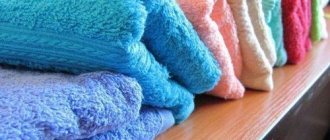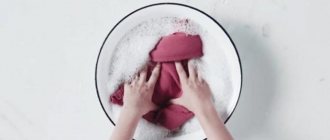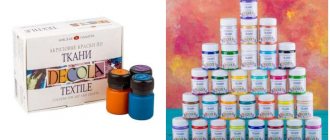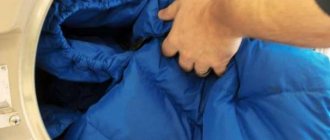One of the main problems of every housewife is dirty kitchen towels, which, it seems, cannot be returned to their original appearance. I wonder why this happens? Why can't many people cope with such a seemingly elementary problem?
All that a modern housewife can do to cope with stains is to buy a couple of products in the store, which in the end either turn out to be completely ineffective or provide a slight improvement in the condition of the towels.
Using soda (+ bleach)
This recipe is suitable for bleaching large quantities of laundry. If you add baking soda to the solution instead of bleach, it can have a negative effect on colored fabrics. This method is ideal for white towels.
Baking soda is the most commonly used ingredient.
To prepare the suspension you will need:
- 120 gr. washing powder;
- 3 tbsp. spoons of soda;
- 3 tbsp. spoons of vinegar essence;
- 15 liters of boiling water.
Mix everything well, place white linen in the solution for 6-7 hours. After which it is sent to the washing machine, where the required washing and rinsing mode is selected. This bleaching method is effective for both waffle and terry towels.
Afterwards, the textiles must be dried and steamed with an iron.
Recipe for whitening kitchen towels with sunflower oil
There are many ways to whiten laundry without boiling. This procedure has a negative impact on the fabric structure, which leads to rapid wear. Whitening at home using sunflower oil is very popular.
Washing kitchen towels using vegetable oil is very easy and simple.
The main advantage of this method is the ability to remove stains even on colored fabrics. The product does not affect brightness and does not leave white spots.
Due to the softening and neutralizing effect in relation to the effects of washing powder and bleach on the structure of fabrics, vegetable oil can delicately whiten towels. This product will make old things sparkle with fresh colors.
The method using vegetable oil is a rather lengthy but effective recipe.
For soaking you will need:
- 2 tbsp. spoons of vegetable oil;
- 2 tbsp. spoons of dry bleach;
- 100 gr. any washing powder;
- 5 liters of water.
Add the above ingredients to boiling water, mix well, and place dry dirty towels into the resulting solution. They are soaked for 2-3 hours, after which they are washed in a washing machine.
Very dirty towels should first be soaked for a couple of hours, and then washed using powder.
How and with what to wash and boil kitchen towels in the washing machine?
Tips and secrets:
- In order to whiten towels not by hand washing or soaking, but using an automatic machine, you should use citric acid.
- The acid should be added to a regular automatic powder (for colored towels, use powder or gel “for colored fabrics,” for white ones, “with bleach”).
- Also add a packet of citric acid into the powder compartment.
- Towels (white) should be washed at high temperatures (from 70 to 90 degrees) in a full cycle (soaking, pre-wash and main wash).
Boiling
This is a very effective and powerful method, especially for completely hopeless specimens. However, it should be remembered that colored kitchen towels should not be boiled.
Heat treatment is the best way to get rid of various pathogens.
To boil towels, you will need a large metal container, which is filled 2/3 with water and powder, bleach, and stain remover are added (2 tablespoons per 1 liter of water or based on the proportions of the instructions). Then place the container on medium heat, place towels in it and, stirring, bring to a boil. After this, the fire is removed and boiling continues for 15 minutes to 2 hours, depending on the degree of contamination.
Colored specimens can be boiled for no more than 15-20 minutes. It is very important to stir the contents.
Do not boil white kitchen towels frequently. Hot water quickly destroys their fibers.
When the procedure is completed, the towels are taken out with special tongs and placed in an empty basin or washing machine for rinsing.
Before boiling with bleach, it is recommended to wash towels in a washing machine or by hand.
This procedure helps remove greasy and other stubborn stains.
Zelenka
Brilliant green is a good dye that can be used to hide faded yellowness. To do this, wash the towel in the washing machine as usual, and then prepare the bleaching medium:
- Dissolve 5-8 drops of brilliant green in 4 liters of water.
- Submerge the towel there for 90 minutes.
- Wash it in the washing machine again.
The yellowness will be replaced by white with a barely noticeable green tint. By the way, bluing works the same way.
With soda and soap
Washing powder can be replaced with a mixture consisting of 72% laundry soap and baking soda. It is better to grate the soap on a medium grater and add 2 tbsp to the water. spoons of shavings per 1 liter of water. Soda - at the rate of 1 tbsp. spoon per 1 liter of water. It is better to prepare the solution in a large metal container, which is placed on fire and boiled for 20 minutes to 1-1.5 hours.
A universal product that will not be superfluous for kitchen towels.
Baking soda and soap are also used separately from each other. The same solution can be used for a washing machine; it is not necessary to boil the laundry, especially if the stains are fresh.
Borax
Boric acid (borax) also works well against traces of fat and gray-yellow coating. It should be used in a ratio of 2 tbsp/4 l of hot water.
Soak the towel in a bowl of solution for 30 minutes and then inspect. If the marks have not disappeared, repeat the process until the stains are gone.
Boric acid is not compatible with terry fabrics.
With butter
Boiling and bleaching dirty towels using vegetable oil? This phrase causes confusion for many. However, there is no mistake here.
Add 3 tablespoons of bleach, powder and oil to the boiling liquid.
Whitening kitchen towels with oil:
- 5 liters of hot water;
- 1/2 cup laundry detergent;
- 1 tbsp. spoon of bleach (powder);
- 3 tbsp. spoons of butter.
Washing with oil is very common among housewives in Japan. For a bucket of water at a temperature of 60 degrees, take 2-3 tbsp. spoons of vegetable oil, as well as 1 tbsp. spoon of vinegar and mustard powder. Dry dirty towels are loaded into the bucket and left for 12 hours. To maintain the temperature for a longer period, cover the reservoir with a lid. After which the towels are rinsed, constantly alternating cold water with hot water. The procedure is repeated at least 4 times.
After cooling, the towels can be washed as usual.
These solutions can also be used for boiling, but not often, since they have a destructive effect on the structure of the fibers, the fabric becomes thinner and loses strength. Soaking according to the specified recipe has a more gentle effect on the fabrics, and the effect will be almost the same.
If the stains are very old, you can first soak the towels in a solution of powder and baking soda: the product will soften the dirt embedded in the fibers of the fabric, and the item will also stop smelling unpleasantly.
After this preparatory procedure, washing with oil will be even more effective.
Washing large amounts of laundry
For bulk washing, this method is suitable:
- Pour 15 liters of just boiled water into a basin.
- Add the following ingredients: half a glass of table vinegar, one glass of washing powder, 3 tbsp. l. dry bleach and half a glass of sunflower oil. Instead of washing powder, you can add grated soap shavings, and instead of dry bleach, you can add baking soda.
- Mix all the ingredients and place the laundry in the liquid.
- Cover the container with a lid and leave for 10 hours.
If you need to wash colored textiles, it is important to consider the following points:
- The composition for washing colored items should not contain ammonia or hydroperite.
- Use bleach for colored items. Before using it, it is advisable to test the substance for its ability to affect the color of the fabric.
- It is permissible to soak things for no more than three hours.
- The water should not be too hot, optimally 40 degrees.
- After soaking, items are washed in the usual way.
With mustard
With mustard you can not only clean, but also disinfect towels. To do this, you need to dilute mustard powder with hot water to a mushy consistency and apply it to wet towels in the stained areas. The mixture is kept on towels for 6-8 hours and then washed.
Thanks to dry mustard, you can tidy up very dirty towels.
How and what is the best way to wash terry kitchen towels?
“Terry” material is not suitable for the kitchen, but some housewives still prefer such towels, as they easily and quickly absorb moisture and pick up any dirt and grease.
How to wash:
- These towels can withstand machine and hand washing
- They should be washed with gel or powder of the appropriate type (colored or white).
- Do not wash kitchen towels with fabric softener (otherwise they will have a water-repellent effect).
French - against unpleasant odor
The French washing method can really return kitchen towels to their original dazzling snow-white appearance, and they will smell fresh. And the main thing is that to get perfect linen, you don’t even need to boil it.
Changing and washing towels should be regular. The best option would be to change every 3 days.
For the procedure you will need:
- 2 pans with a capacity of 6-7 liters;
- 1/4 piece of laundry soap in the form of shavings;
- 5-7 crystals of potassium permanganate.
To begin, pour water into both pans and bring to a boil. 5-7 crystals of potassium permanganate dissolve in one of them, and care should be taken that the water has a pinkish tint, but not dark. In another saucepan, stirring constantly, dilute soap shavings. Then the contents of both pans are poured into a large basin and the towels are loaded there for 6-7 hours. You can cover the basin to keep the water hot for as long as possible. After the time has passed, the laundry is washed and rinsed in the usual way.
Buy potassium permanganate from gardening stores and add it to your laundry.
This method is ideal for whitening and freshening items, but is not suitable for fabrics that cannot be washed at high temperatures. It is also well suited for baby diapers: it copes well with stains and avoids allergic reactions on delicate and sensitive baby skin.
Helpful advice
Towels that are made from colorful or dark fabrics are best for drying hands while cooking because grease and other contaminants are much less noticeable on them. And, of course, whenever possible, try to wash your oily hands rather than just dry them with a towel. An alternative is paper napkins.
Washing kitchen towels won't be a headache if you have a lot of them in the kitchen and you change them often. Ideally, you should have a towel to cover fresh baked goods, dry your hands after washing dirty dishes, dry your hands during the cooking process, dry fruits and vegetables, and so on.
To prevent those stained towels you use all day from ruining the entire look of your kitchen, simply toss them in a nice basket—not too high, not too low.
Silicate glue
To remove the most stubborn stains on kitchen towels made of natural fabric, you can use regular silicate or office glue. To do this, dissolve soap shavings from 1 piece of laundry soap in 10 liters, add 1 tbsp. spoon of silicate glue. It is necessary to boil the towels for 30-60 minutes. Then they are loaded into the rinsing machine and you get perfectly clean and fresh laundry.
Silicate glue is suitable for washing very soiled items.
For coffee stains
Coffee is a wonderful aromatic drink, but getting rid of its stains, especially on colored things, is sometimes difficult. How can you wash soiled kitchen towels at home? The usual remedies can come to the rescue: citric or oxalic acid, hydrogen peroxide, salt, soda, glycerin, vinegar, ammonia or bleach.
It is recommended that very dirty towels be soaked first and then washed.
The easiest way to wash kitchen towels made from natural fabrics from coffee stains:
- First, fresh stains must be rinsed in running water and wrung out;
- moisten the stain with regular lemon juice and leave the towel for a while. The juice breaks down dyes very quickly.
If tea or coffee is spilled on the tablecloth, the stain should be covered with salt; it will absorb most of the dirt.
Getting rid of stubborn marks is quite difficult.
Some tips for removing coffee stains:
- Mix 2 tbsp. spoons of glycerin with 1/2 teaspoon of ammonia and apply to the stain using a cotton pad. Leave for a while, then wash off the stain and wash the product in a washing machine on a standard cycle.
- Prepare a paste of glycerin and table salt and apply to the stain. After it disappears, rinse the stain and wash the towel.
- Heated glycerin is applied to the stain and left for 15-20 minutes, rinsed off and washed in the usual way.
- For colored fabrics, you can use a 10% solution of borax in glycerin, which can be purchased at the pharmacy. The coffee or tea stain should be treated with this solution and left for a couple of minutes, then rinsed with cold water. There may be small stains that will disappear after regular washing.
- It is necessary to dissolve a tablespoon of vinegar, 1 teaspoon of table salt and 1 teaspoon of lemon juice or 1/2 teaspoon of citric acid in a glass of water. Pour the solution into the stain and leave until it disappears, then load the towels into the machine and wash. This method can also be used for wool fabrics.
- Pre-soaking in a solution of ammonia and water in a 1:1 ratio for 1 hour will help remove coffee stains from towels.
- There are a huge number of household chemicals for removing all kinds of stains. Almost all of them cope with bleaching already during the first wash, if the stains are fresh. But with the old and dried out, we will have to fight.
It is recommended to use hot water - this way the breakdown of fats occurs much more actively.
Edible lemon
Lemon is also an acid that effectively removes fatty residues. Before the procedure, you need to wash the towel with regular washing powder, and then:
- Sprinkle the powder generously onto the stains. It is better to take finely ground lemon or grind it yourself in a mortar - this way it will begin to react faster.
- Leave it for an hour to form a stable acidic environment.
- Then wash the item in running water. You can add soda to “quench” the remaining lemon juice.
Using a microwave
This method is very effective, but you should take into account the fact that the smell of powder or bleach may remain in the microwave oven for a long time, and you may even have to wash and ventilate it. Otherwise, you may end up with heated food that smells like household chemicals. The best option is to use an old microwave.
You can wash kitchen towels in the microwave in just a couple of minutes without much effort.
When carrying out this procedure, you cannot be distracted; everything must be under control and timed. It is prohibited to increase the power and duration, since the plastic bag is a flammable item.
How to bleach correctly:
- For one bookmark, take no more than three towels. They should be wetted and anti-stain applied or well soaped with laundry soap. When removing greasy stains, you can use dishwashing detergent. The foam on towels, especially in stained areas, should be plentiful.
- Then the towels are placed in a tight plastic bag that is not tied.
- Set the power to 400-500 W and turn on the microwave for 90 seconds.
- After receiving the readiness signal, you should carefully check the temperature of the towels so as not to get burned. They must be hot, otherwise the procedure must be repeated.
- To avoid burns, hot towels are removed from the oven with kitchen tongs and placed in the drum of a washing machine for rinsing, or rinsed by hand.
- Subject to safety precautions, this method will allow you to wash towels simply, quickly and easily. This unusual washing will help give the fabric its pristine whiteness and cope even with old stains, and most importantly, save time.
The best way to bleach fresh stains is to use a microwave.
This method can be used many times, it is effective not only for towels, but also for T-shirts and shirts.
General rules
If the following rules are followed, then things will not fade or take on a shabby appearance; they will not have to be washed, bleached or boiled often:
- Buy several kitchen sets to use and have in reserve for shifts.
- While the stains are not visually noticeable, do not rush to wash them. The towel can last in the kitchen for two to three days. If you keep it clean for a longer period of time, it is enough to change it once a week.
- After washing, iron the items; this will make them look neat and keep them clean for a longer time.
- Use napkins or cloths to wipe the dirty surface of the table or stove. They will not need to be thoroughly washed and, if desired, you can simply get rid of them by throwing them in the trash.
Terry fabrics are not suitable for the kitchen. Because of the absorbed moisture, they dry out more slowly and harmful microflora begins to develop in them. It’s better to buy waffle cotton or linen products. At home, you can get rid of dirt from terry products and bleach them using vegetable fats.
It is difficult to get rid of old stains, so it is recommended to wash kitchen textiles more often. Things from the kitchen have greasy stains and when washing they need to be separated from ordinary things. But if they are odorless and practically clean, then this is not necessary; all that is required is sorting by color.
When you are working in the kitchen, it is better to use disposable paper napkins. After wiping dishes or hands with them, you can simply throw them away. You can wipe off any dirt and grease with napkins, and it is better to blot moisture from washed hands with a cloth product. And untidy spots will appear less often.
Vinegar
You can use something as cheap as vinegar to wash almost any item. It should be added to your laundry essentials such as powder and bleach.
If you add just 1/2 cup of vinegar to the washing machine with each wash, it will protect fabrics from fading, dissolve soap scum on them, enhance the effect of the powder and clean the heating element from scale. It can be used as a rinse conditioner, especially to soften terry towels. It also helps remove pet hair and static electricity.
Adding vinegar when rinsing will help remove yellowness from white fabrics.
Don't be upset if coffee, wine, chocolate or jam gets on your T-shirt, jeans or favorite blouse. It is enough to have a spray bottle of vinegar on hand; it is very convenient to spray it on the stain. After which the product or towel should be left for 15-20 minutes, and then simply washed. Vinegar is safe for both natural and synthetic fabrics.
If the item sheds a lot, you can soak it in a solution of water and vinegar for 15-20 minutes before washing. It is ideal for washing swimwear and delicate items. All unpleasant odors, including tobacco and mold, will be removed by washing and rinsing things with the addition of vinegar.
A very effective way to remove stains is to soak kitchen towels with greasy stains in a solution of warm water and vinegar in 1:1 proportions.
Sometimes towels become victims of fungus or mold. To remove them, use 9% vinegar to moisten the stains and leave for 20 minutes.
Even such an everyday task as washing can be made easier, and you can delight yourself and your loved ones with excellent results if you follow some useful tips:
- When boiling laundry, add 1 tbsp for every 10 liters of water. a spoonful of ammonia.
- When washing tulle, in addition to the bluing, you can add 1/2 cup of milk to the water. Clean curtains will amaze you with freshness and newness.
- To make it easier to remove stains on white towels, they should be soaked in water with boric acid before washing.
- Terry towels will become soft if you soak them in salted water for 10 minutes during the rinsing process.
- When washing colored towels, you can add 2-3 tbsp to the washing machine in addition to detergent. spoons of salt. This will make the colors more vibrant.
- If you need to do a little laundry while traveling, you can use a thick plastic bag. Fold the laundry into it, add detergent and add a little water. Then tie the bag, knead the contents a little with your hands and shake lightly. This will be enough to quickly and without much hassle put things in order.
- It is necessary to take into account that each type of pollution has its own methods and means, but it is worth adhering to the well-known scheme for combating them:
- pre-soaking;
- washing at the correct temperatures;
- washing with chemical and folk remedies;
- boiling is used in extreme cases and not with all tissues;
- each subsequent stage is used if the previous one did not give a visible and desired result.
Our tips, rules and recommendations will help you cope with stubborn and fresh stains using traditional methods at home.
Hydrogen peroxide
Peroxide is a powerful oxidizing agent and solvent. It does a good job of removing greasy marks and yellowing on textiles, including old ones. Just wet the trail and forget about the towel for a few hours.
Installing a siphon under a kitchen sink with your own hands: assembly and connection diagramHow to wash a suspended ceiling so it looks like new
The most interesting and useful little things for your kitchen
By the way, peroxide has a “big brother” - a cosmetic hair oxidizer. You need to work with it more carefully, but the efficiency is also higher.
Important, the oxidizing agent is EXCLUSIVELY suitable for light-colored towels. On colored people it will leave noticeable white spots.











